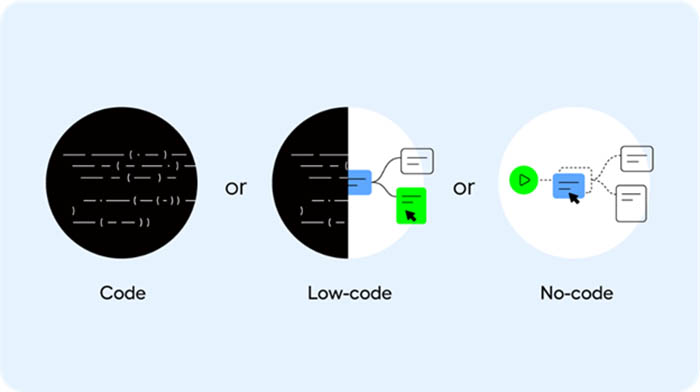Low Code vs No Code Test Automation: A Complete Comparison Guide
In today’s world where software makes moves quickly, it’s super important to make sure the apps we use work well and can be trusted.
Testing these apps to check their quality is a big part of this. But, doing all this testing by hand can take a lot of time and be boring.
That’s why having computers do the testing for us can help – we can get things done faster without as much hard work.
But here’s the thing – usually, you need to know a lot about coding to set up this kind of automatic testing, and only some who test software know how to do that.
This has made it hard for lots of tests to be done because more people need to set them up.
With easy-to-use tools and clear steps, low-code/no-code test automation lets more people get involved in testing. Let us look at how they make automation simpler.
What is Low-Code/No-Code Testing?

Low-code/no-code test automation tools make it easier to create automated tests by allowing testers to write scripts without requiring considerable coding knowledge.
With low-code tools, you can make automated tests with very little coding. This is done using ready-made parts and a drag-and-drop method.
No-code tools go even further, letting you create and run tests without needing to code at all.
These tools use easy interfaces, guided steps, and ready-made templates to help through the test automation process.
Instead of writing complicated code, you just pick what you want to test, what should happen, and what the outcome should be.
The tool does the rest. This makes it easier to start doing automated tests quickly and helps teams work faster and more efficiently.
Visual and Intuitive Interfaces
The big thing about low-code/no-code tools is that they’re really easy to use.
They’re built so that anyone testing can easily work their way around setting up and doing tests without facing tough coding tasks.
A lot of these tools let you just drag parts or actions into place to design your tests.
Also, these tools guide you step by step on how to get your automated tests up and running smoothly.
This means less time figuring things out for new testers and more consistency in how tests are done across your team.
Pre-built Components and Templates
Another advantage of these tools is they come with lots of pre-made components and templates for various common test actions like clicking buttons or entering info into fields.
You can mix these parts however you need for your test without starting from zero coding-wise.
Plus, there are ready-to-go templates for many standard types of testing which help get your testing going quicker while making sure good testing habits stick within the team.
Accessibility for Everyone
One of the key benefits of Low-Code/No-Code test automation is its accessibility, which allows testers of diverse technical expertise to contribute to the testing process.
Low-code/no-code testing opens up the world of test automation to everyone, not just coders. Before, you needed to know how to program to create automatic tests.
This meant many people couldn’t join in because they didn’t know coding. That’s no longer a problem.
With these simple-to-use tools, anyone can set up automated tests without needing much, if any, experience with coding.
This means more people can help with testing and makes teams work better together.
Even if you’re not a tech expert, you can still offer great ideas and help make the software better.
Upskilling and Career Growth
With the top low-code/no-code automation testing tools, testers may design and execute test scripts without writing sophisticated code, speeding the testing process.
These easy tools also mean that people who don’t know coding can learn about automatic testing on their own. This is good for their careers.
As teams work faster and use new ways of making software, they need people who understand these handy tools.
Learning how to use low-code/no-code tools can make you stand out at your job.
Plus, by showing you’re good at using these tools, new job chances can come up.
You could become an expert in automated tests or lead testing projects yourself. It’s a great opportunity to do more exciting work and feel happy about your progress.
Time and Cost Savings
Starting with automated tests usually takes a lot of time and money. Sometimes it’s too much for companies with small budgets or tight deadlines.
Low-code/no-code tools are here to help by offering a way to automate tests that don’t take as much time or money.
These tools are easy to use and come with pre-built components, so people can get their automated tests going quickly without needing lots of training.
This helps save a lot of important time and also cuts down on the costs linked to setting up test automation.
It makes it easier for all sorts of groups, from new small companies to big ones, to adopt these tools.
Moreover, saving time and money doesn’t just happen at the start.
These low-code/no-code testing tools have smart features like self-fixing tests and updates that happen on their own.
These features mean less work is needed to keep the tests current when the app changes.
Over time, this makes these tools a cost-effective choice that continues to pay off.
With the benefits of low-code/no-code test automation, testers can efficiently automate repetitive processes, saving time and effort during testing.
Quicker Product Launches
By making the process of testing automatic and accessible to everyone, even those who aren’t technology experts, tools that are easy to use can help a company get its products out there much faster.
This means tests can be set up, run, and updated more quickly, covering more ground and finding any problems early on.
This leads to getting feedback sooner and fixing any issues fast, cutting down the time and work it takes to get each version ready.
Companies can then keep up with or stay ahead of changes in what people want or what other companies are offering.
Also, saving time with these user-friendly testing tools means the team has more hours for other important work like coming up with new ideas, making their product better, and trying out new tech.
Being able to move quickly and adapt in this way is a big plus in the competitive world of digital products.
Choosing the Right Tool

When picking the perfect tool for your team, it’s super important because of how popular low-code/no-code testing is getting.
There are a lot of options out there, each with its unique features.
Choosing wisely can help your work go smoothly and get all the good things out of the technology. Think about what matters most when looking at these tools.
Understanding Your Testing Needs
First, you need to get what your group needs to test.
This means figuring out what kind of apps you’re dealing with, what tests you want to run automatically, and any special things your test setting needs.
For instance, if you’re all about web apps, find a tool that’s great at checking them on different browsers.
But if mobile apps are your main thing, you’ll need a tool that’s awesome for testing on phones or tablets, including checking how they look on different devices and support for all kinds of mobile systems.
Also, think about the tests you gotta do – is it checking if things work right (functional testing services), making sure updates don’t mess anything up (regression testing), how fast things run (performance testing), or keeping things safe (security testing)?
Some tools might be top-notch in one area but not so great in another.
Knowing what’s most important helps focus on tools that meet your needs, helping everything go smoothly and making the most of what you spend.
Top low-code/no-code automation testing tools include simple and user-friendly interfaces that enable testers to build, deploy, and maintain automated test cases quickly.
Evaluating Integration Capabilities
Testing needs to fit in with CI/CD pipelines, managing tests, keeping track of issues, and more.
When choosing your tool, see how well it plays with others.
Things like easy connections to CI/CD tools like Jenkins or GitLab can make life easier by automating tests during build-ups and finding problems faster.
Finding a tool that matches well with what you already use means less headache trying to make everything work together and more smooth sailing through your tasks.
Also, think about if the tool works well with your test management tools. This can help you keep all your test cases, results, and bugs in one place.
When everything is connected, it’s easier to work together, share updates, and keep track of everything during testing.
Then, take a look at how the tool connects with other software through APIs or custom options.
This means you can link it up with other tools or systems you use, which makes sharing data and automating tasks across your whole project much simpler.
Choosing a tool that easily fits into your current workflow without causing problems is key. This way, you get more out of what you spend with less trouble.
Scalability and Maintainability Considerations
As your company grows and needs more complex testing, it’s crucial to pick a testing tool that can grow with you.
- A tool that seems good enough now may not cut it as your tests get bigger or you have more software to check.
- Make sure the tool can handle more tests, different types of tests, and lots of test information.
- It should let you manage tests easily, run many at once, and do tests across different places. This helps make sure your testing can keep up as you need it to.
- Also, look for a tool that makes updating tests easy as your software gets updated.
- Tools that fix themselves or update automatically make it easier to keep tests current, so they always work right.
- Check if the tool will get new updates and features down the road.
- A tool that keeps improving is likely to stay useful as your needs change, helping you stay ahead in the long run.
Choosing a tool with growth and upkeep in mind from the start means your choice will support your company’s needs into the future, making sure you get the most from your testing efforts.
A low-code test automation platform makes it easier to create automated tests, allowing testers to write strong test cases without having substantial coding experience.
Assessing User Experience and Ease of Use
When searching for easy-to-use tools that help your group test software without having to be experts in coding, it’s really important to pick ones that are simple for everyone.
- You want a tool that doesn’t require a lot of tech knowledge and helps users get the hang of it without much trouble.
- Try to find programs that are straightforward to move around in, with steps and layouts that make sense.
- If the program lets you use pictures or drag things instead of coding, it can be a big help.
- This way, creating tests is less about tough code and more about putting together pieces in a way that makes sense.
Evaluating Reporting and Analytics Capabilities

When you’re looking at these tools, don’t forget to check out how they handle reports and data analysis.
- Understanding how your tests are doing is key to making them better over time.
- Look for programs that let you customize reports and have clear charts or stats so you can quickly see what’s working and what’s not.
- Sharing these reports should also be easy so everyone involved knows what’s going on.
- It helps if the tool can work with other data systems you’re using.
- This way, you can bring all your info together for a full picture of how testing fits into your projects overall.
- Being able to dive deep into why tests might not work as expected or spotting performance issues is super important too.
- So, look for tools that give detailed records and analyses of each test run.
- Picking out these features will give you insights into improving your testing game, helping catch problems faster along the way.
- Also, check if the tool can watch over your tests as they happen and let you know right away if something goes wrong.
- This way, you can quickly deal with any issues and keep things moving smoothly without any hold-ups.
- Make sure to look into how good the tool is at giving reports and analyzing information while you’re deciding which one to pick.
Partnering with a reputable Software Testing Company in India guarantees comprehensive testing strategies geared to your demands.
As more people are starting to use tools that let you test without needing a lot of code, there’s a bunch to choose from out there.
Each tool has something special about it, so picking the right one is key for making sure things go smoothly and you get all the benefits from using it.
Here’s what to keep in mind when looking:
1 What and how you’ll test
Think about if you’re working on the web, phone, or computer programs and what kind of testing you need like checking if things work right, finding bugs before updates, or seeing how fast it runs.
2 Working with what you’ve got
See if the tool can work well with the setup you already use for making and testing your software.
3 Growing needs
Make sure the tool can keep up as you do more tests over time and help keep everything running smoothly as your projects get bigger.
4 Help and learning
Look into what kind of help and learning resources are available with the tool so you can fix problems more easily, share tips, and stay in the know on updates or helpful tricks.
By taking these points into account and matching them with what your team does and needs, picking the right tool could help make the testing way easier.
Overall, using a low-code test automation platform democratizes automation by making it available to a broader spectrum of testers and allowing enterprises to achieve faster, more reliable software delivery.
Best Tips for Using Easy Testing Tools

When you’re using easy testing tools, which don’t need much coding, it’s really important to do things the right way so everything works well and keeps working in the future.
Here are some top tips to help you do just that:
1 Make a plan
First, figure out where using these tools will help the most and make those areas a priority. Then, lay out a step-by-step plan for setting up and keeping your tests updated.
2 Work together
Get everyone on your team involved, whether they know a lot about technology or not. This way, everyone can pitch in ideas and help out.
3 Set clear rules
Decide on some rules for how to put together and look after your tests like how to name them and how they should be organized.
This makes sure everyone does things the same way and it’s easier to keep track of everything.
4 Keep things current
Don’t forget to check on your automated tests regularly to make sure they still do what they’re supposed to do as your software changes.
5 Fit it into what you already do
Try to make these testing tools work with the systems and processes you already have in place, like your software delivery routines or how you keep track of problems.
6 Watch how it’s going
Use ways of measuring how well your automated tests are doing so you can see what’s working and what needs to get better.
By using these tips, teams can get the most out of easy testing tools and make sure their use is smooth and effective alongside their existing software-making and testing activities.
Overcoming Challenges and Limitations

Image Source – https://www.linkedin.com/
Even though low-code/no-code tools bring a lot of ease into test automation, there are still some hurdles and limits we need to face when bringing them into play.
1 Limited Customization and Flexibility
A big worry with these tools is they might not be as bendable or customizable as the usual coding ways.
They often come with set parts and layouts which can make it tough to craft very detailed or complex tests.
Also, some of these tools might not work well with older software or very specific tech needs.
To get around this, it’s key for teams to think about what they need from their tests and pick a tool that fits those needs best.
If the tool doesn’t naturally cover everything, looking into how you might add to it or maybe mixing low-code/no-code tools with traditional coding for those trickier tests can help.
2 Vendor Lock-in and Dependency
Choosing a low-code/no-code tool means you’re somewhat in the hands of its creators for updates, support, and keeping the tool running smoothly.
If the creator stops working on the tool or changes how much it costs, this may disrupt your team’s workflow or force you all to switch to something else both of which would take up time and effort.
To lessen this risk, doing your homework on the tool’s maker like their plans for the tool, financial health, and how committed they are to keeping it up is wise.
3 Skill Development and Knowledge Transfer
These tools aim to make automation more approachable for everyone, even people who aren’t tech experts.
But there are still things to learn like how the tool works, what features it has, and tips for using it best.
- Tackling this challenge means offering good training and help resources for your team members
- Promoting a culture of knowledge-sharing and collaboration
- Pushing for learning across different functions within your team,
- Making use of training materials from the company that made the tool plus advice from its user community.
Also critical is keeping a healthy mix of low-code/no-code testing with classic coding practices in your team’s skills toolbox.
This way, valuable programming know-how stays sharp, and adapting to new test needs or tech shifts remains smooth.
4 Test Data Management and Security
Managing tests and keeping data safe is very important for making sure automated tests work well.
Some tools that don’t need much coding might not be so great at handling or protecting test information.
This could make it hard to create test data, hide the details in the data, and keep sensitive information safe.
Organizations should do the following:
- Look into how a tool manages and protects test data
- Set up strong rules and steps for handling data
- Work with other tools for managing data if needed
- Follow laws and rules about keeping data private and safe
By taking care of these issues early on, groups can get the most out of tools that don’t need much coding while avoiding problems and making sure they can use them smoothly over time.
What’s Next in Testing ( Future Trends and Advancements)

The world of easy-to-use testing is changing fast, with lots of new things coming.
As tech gets better, these tools will be more powerful, smart, and easy for everyone to use. This will make automating tests easier and improve the quality of software.
1 Using AI and Learning from Data
More and more, AI and learning from data are being added to these easy-to-use testing tools. They make testing smarter by doing things like:
- Making New Test Cases: AI can look at code, what needs to be done, and existing tests to come up with new ones by itself. This means less work by hand.
- Fixing Tests on Their Own: Learning from data can spot changes in apps and update tests to keep them working well.
- Picking the Best Tests: AI can figure out which tests are most important based on their results, helping speed up testing.
2 Testing Without Writing Code
In the future, there might be even more straightforward ways to automate tests without writing any code at all.
These future tools could understand simple instructions or pictures showing what the test should do without any tricky programming.
3 Cloud-Based and Collaborative Testing
As working online together becomes more common, these testing tools will likely move online too. They might let people:
- Run Tests Everywhere: You could run tests on many devices or in different places using online services.
- Work Together in Real-Time: People can make, run, and fix tests together no matter where they are.
- Keep Everything Organized Online: All the tests, their data, and results would be kept online where everyone can see them easily which helps people work together better.
4 Using DevOps and Agile with Low-Code/No-Code Testing
As more people use DevOps and agile, tools for testing without needing to code a lot (or at all) are getting better at working with these methods. This includes things like:
- Testing All the Time: Tests run on their own during ongoing updates and releases, which means problems get spotted and fixed quickly.
- Testing Early On: Tests happen sooner in making something, which helps find issues faster so they can be dealt with sooner.
- Setting Up Test Spaces Easily: Making and adjusting spaces for testing is done automatically, making the whole process smoother and less of a hassle.
5 Easier to Use for Everyone
Tools for testing that don’t need much (or any) coding are already pretty easy to use.
But they’re going to get even easier, welcoming more people to give them a try. This could mean:
- Talking or Typing Instructions: You might be able to just say what you want to be tested or type it like you’re chatting, which makes technical know-how less necessary.
- Using VR and AR: Using virtual or augmented reality solutions could make it feel like you’re right there with what you’re testing, making it more fun and helpful.
- Helpful Features for Everyone: These tools will have features to help people with different needs use them too, making sure everyone can join in.
Conclusion
Testing without needing much (or any) coding is changing the game for how tests are automated. It’s welcoming anyone to try their hand at automating tests, leading to covering more ground with tests quicker feedback, and better quality in what’s made.
By making automation something everyone can help out with not only does it save time and effort but also brings teams closer together as they share what they know.
Tools that help us test software are getting better all the time, because of new advances in technology like AI.
These advancements indicate that we may expect even more distinctive testing in the future, making it easier and more accessible to everyone.
Have you tried using easy-to-use testing tools at work? How did it go? If you haven’t used them yet, what’s stopping you? Let us know in the comments below!
FAQs
1) Can these easy testing tools be used for every kind of test?
These tools are super flexible and great for lots of different tests like checking if things work right (functional), making sure changes don’t break anything (regression), and looking at the whole system (end-to-end). But they might not be the best choice for very specific tests focused on speed or safety. It’s a good idea to see what these tools can do and if they fit what you need. Sometimes, you might need to use other tools too.
2) Will these tools take over traditional testing methods that need a lot of coding?
Nope, these tools aren’t here to completely replace the old-school ways where you write lots of code to test software.
They’re here to help out by giving an easier option for people who aren’t coding experts or when you don’t have many coders around.
Many teams use both kinds of tools together depending on what they need for different tests.
3) What happens when the app changes – do these tools keep up?
The newest versions of these easy-testing tools are pretty smart! They have special features that let them automatically fix themselves and update tests when your app gets updated.
This saves a ton of time because you don’t have to update tests by hand whenever something changes.
4) Can you mix these tools with other testing systems we already use?
Yes! Lots of these tools are made to work well with other testing setups, things that help manage your project (like CI/CD pipelines), and other usual development tools. This makes it simple to add them to what you’re already doing without a hassle.



